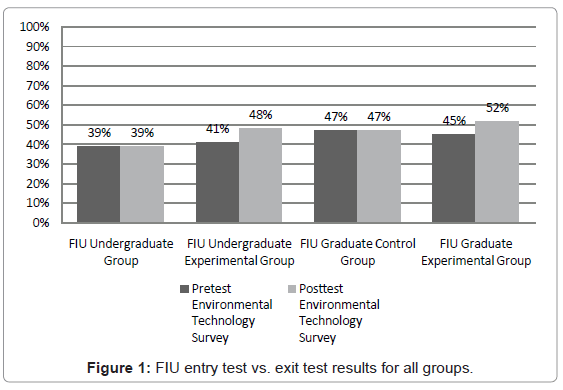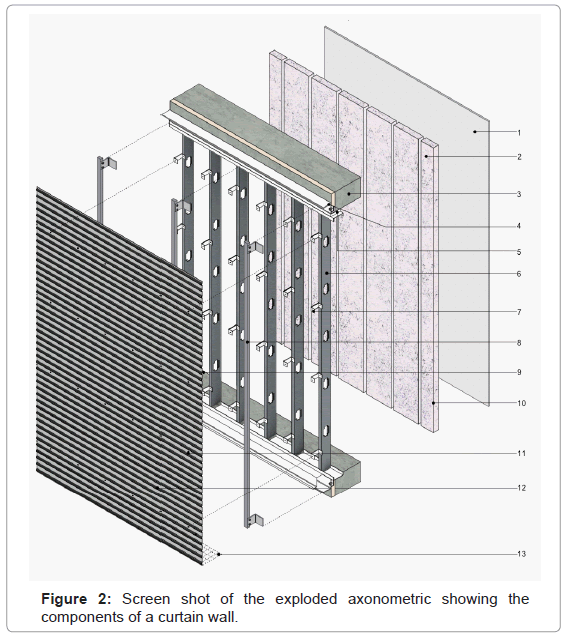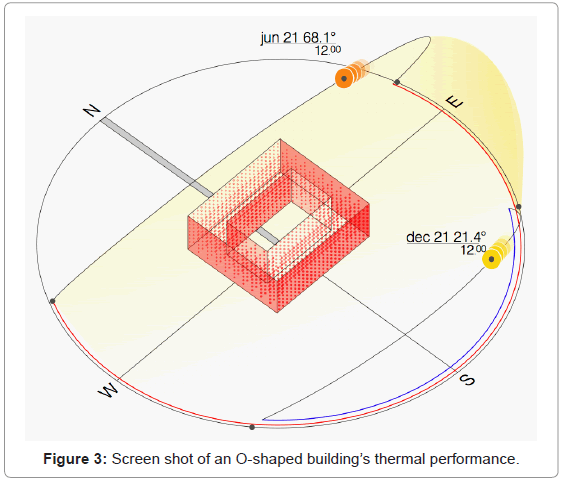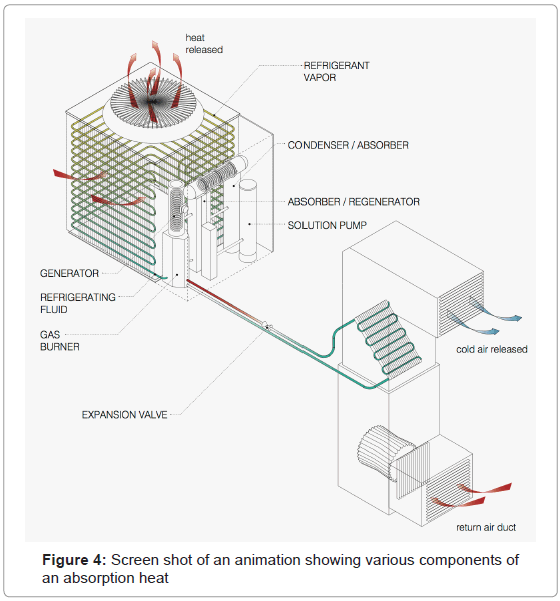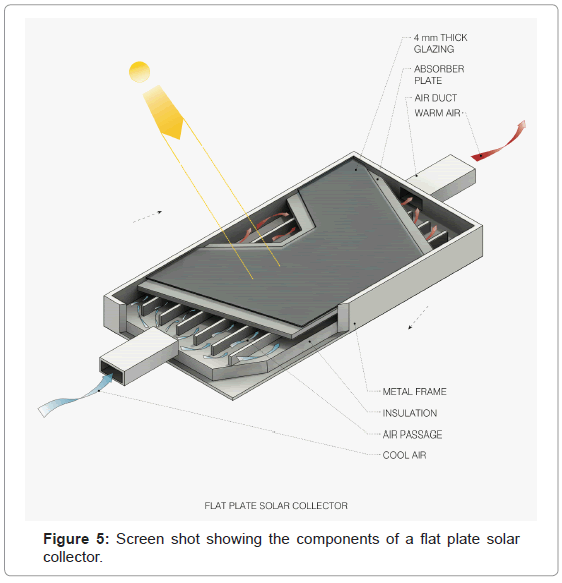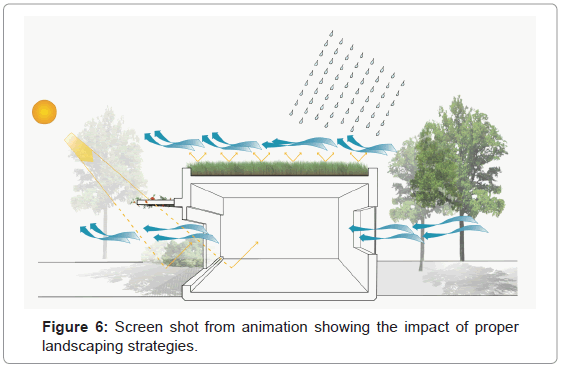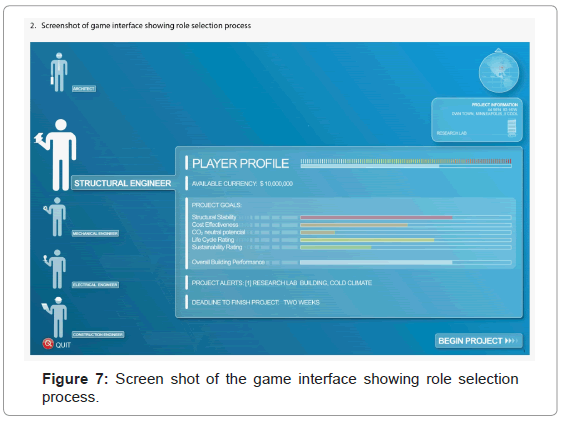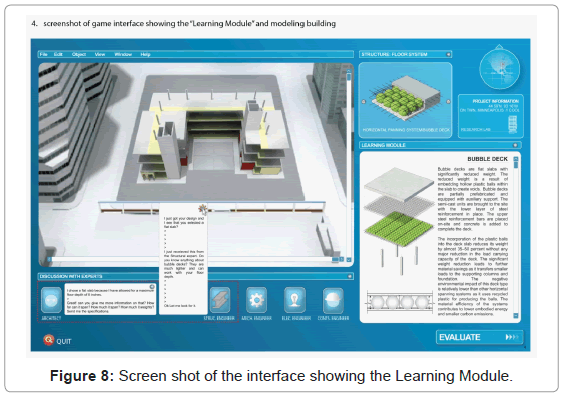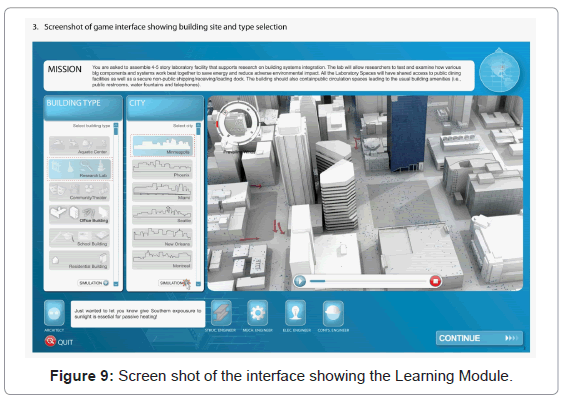Leveraging Cyber-infrastructure to Transform Building Science Education
Received: 08-Oct-2012 / Accepted Date: 11-Dec-2012 / Published Date: 19-Dec-2012 DOI: 10.4172/2168-9717.1000105
Abstract
One of the most promising applications of computer technology has been in developing in educational games. Advances in technology and cyberspace capacity coupled with emerging research in science education are creating new opportunities to enhance architectural education in the science and technology areas and prepare students for effective collaboration with other stakeholders in the building industry. This paper presents a completed case study and shares research in an ongoing study that addresses the need for innovation and improvement in science and technology education. The authors propose that using advances in digital technology to engage students in interactive learning is a necessary step toward better buildings. Using new technologies to re-think the education of the architect in the relation to integrated practice reinforces the role of architecture in science, technology and mathematics.
Keywords: Cyberlearning; Education; Technology; Integrated practice
73532Introduction
The construction and operation of the built environment critically impacts the global economy and environment. Building construction affects international trade, global commodity prices, labor, and employment markets. The building sector touches nearly every industry from steel, insulation, and caulking to mechanical and electrical equipment, glass, wood, metals, tile, fabrics and paint. Building construction involves all sectors of the U.S. economy including architecture, planning, design, engineering, banking, manufacturing, construction, wholesale, retail, and distribution [1].
The U.S. building sector is one of the planet’s most significant contributors to climate change. The construction and operation of buildings in the U.S. is among the most energy, pollution, and resource intensive of all human activities, consuming three billion tons of raw materials, 49% of the nation’s total energy and 77% of its electricity each year [2]. Materials utilized in buildings have high-embodied energy, contain high levels of toxins and pollutants, and give off high levels of emissions [3]. Given the size of building industry’s environmental impact, the professions involved in building design and construction have considerable capacity to reduce national energy consumption, significantly reduce impact on climate change, improve national energy independence, diminish the adverse impact of buildings on the environment, and improve sustainability of our cities and economy.
Nationally, considerable effort has been made to support the design and development of high performance, energy efficient, and more sustainable buildings, including the development of the Leadership in Energy and Environmental Design (LEED) system of building performance evaluation and professional accreditations. However, the success of current sustainable building design standards and practice is negligible on a national basis. The fundamental problem is that both the educational system and professional practice of the disciplines responsible for building design and construction Architecture, Engineering and Construction (AEC) professionals-have structural and institutional flaws, which if not addressed, permanently curtail the development of a truly sustainable built environment.
The most recent research in building design conclusively demonstrates that the most resource efficient, best performing, and environmentally sustainable buildings are designed using Integrated Practice Extensive research by the National Institute of Building Sciences indicates that when AEC professionals collaborate early, at the start of a building design project, this process produces better designed, more efficient, and lower cost buildings (references). Integrated Practice is the process by which AEC professions work together at the conception of the project to improve overall building performance [4].
Improving Integrated Practice has been recognized by the American Institute of architects (AIA) as one of the central challenges facing the profession, and one the most important ways to improve building performance, cost and environmental impact. The AIA, in its AIA 2030 Commitment, has challenged the profession to achieve the goal of designing Carbon-Neutral (using no Greenhouse Gas Emitting Energy) buildings in the U.S. More importantly, the 2030 Challenge identified Integrated Practice as the primary vehicle to attain this goal. Unfortunately, Integrated Practice is the exception rather than the norm in the development and construction of the vast majority of buildings in the U.S. Neither the AIA, nor other institutions, have a clear plan for significantly increasing the implementation of Integrated Practice. The struggle to for Integrated Practice is rooted in fundamental problems within the education and practice of AEC professionals [5-8].
There are several challenges facing the incorporation of Integrated Practice into AEC professional education. First, the practice of contemporary building design and construction is split into increasingly specialized and fragmented components professional and knowledge “silos,” within which architects, engineers, and construction managers fail to communicate and collaborate effectively. On the other hand, Integrated Practice requires ever more demanding technical and collaborative skills to arrive at innovative solutions to the complex and competing demands of society, the building industry, and the natural environment.
Second, not only does the level of knowledge and skill required for professional practice increase each year, but the existing divisions and knowledge silos in perpetuated in the AEC professions are becoming more pronounced in the education of the AEC disciplines in academia. AEC students leaving the academy increasingly ill prepared in the requisite technical skills and without any experience in collaborative or Integrated Practice project assignments. AEC education has an extensive focus on domain-specific knowledge without building adequate general domain competencies. General domain competencies are essential in managing problem solving process activities as well as developing the ability to effectively engage in Integrated Practice.
According to studies conducted by Wuff and Fisher “Many of the students who make it to graduation enter the workforce ill equipped for the complex interactions, across many disciplines, of real-world engineered systems” [5]. The National Academy of Engineering Report (2004) points out that a critical component needed for engineering curricula is to foster an understanding of the interrelationships between engineered, technical, and non-technical systems. An article entitled “The Vision for Civil Engineers in 2025” [9], states dramatic changes to civil engineering practice are needed in order to answer emerging challenges, requiring civil engineers to acquire not only an extended technical skills but also nontechnical knowledge in actual professional practices.
Though large-scale reform of AEC education is a complex, ongoing national debate; researching effective learning models that stimulate Integrated Practice can result in alternatives to better train AEC professionals, which is critical to the future of the nation. This paper describes the design of an integrative learning environment that supports a context for an experience-based multi-disciplinary education that includes Integrated Practice. The design of this learning environment evolves from our project entitled Building Literacy: the Integration of Building Technology and Design in Architectural Education (2001).
The Building Literacy project was supported by the US Department of Education’s Fund for Improvement of Postsecondary Education from 2007 to 2011. This is also when the re-designed lecture courses were offered. The project developed a software package aimed to advance the education of climate responsive and ecologically sustainable building design in architectural curriculum by examining alternative pedagogical methods. The project entailed a comprehensive approach to engage students in learning multiple aspects of building design including structural science, construction methods, and environmental systems (lighting, electrical, plumbing, heating, and cooling and ventilation. The project was implemented and tested in architecture programs in parallel institutions. The testing and evaluation results showed statistically significant improvement in student learning outcomes.
The proposed integrative learning environment called “Cyber Construct” expands the Building Literacy project to the broader AEC disciplines by introducing a gaming environment with a player dialogue component as a pedagogical method to simulate Integrated Practice. Cyber Construct is a Multi-Player Online Role Playing Game (MORPG) that aims to enhance the interactive learning possibilities of the Building Literacy project by expanding it to a digital game environment. The design of Cyber Construct builds further on the most recent educational research and investigates a number of learning models including the cognitive, dialogic, and situated learning [10].
The following sections first provide a description of the building literacy project to show the motivation for a Cyber Construct learning environment, followed by discussions of contemporary learning theories and a case study outlining the game scenario demonstrating the application of the theories. Finally, some conclusive remarks are provided.
Building Literacy: The Integration of Building Technology and Design in Architectural Education
The core pedagogical principle for developing Building Literacy was that a self-directed interactive educational format is critical for engaging students in the process of learning. Recent studies show that the passive lecture format or “instructional paradigm” where the teacher lectures and the students listen may not be the most effective setting for learning [11]. Consequently, educational researchers have focused on promoting student centered learning environments that provide highly interactive, task oriented educational materials enabling students to control the pace of their own learning.
To achieve high level of interactivity the Building Literacy project harnessed the advances of digital media such as interactive diagrams, animations, and hyperlinked analytical data and graph exhibits to deliver the content. The project aimed to aid students to learn at the level of their individual ability, while receiving support for their activities. The specific objectives of the project were to:
• Produce an innovative building technology learning environment which took advantage of the interactive capabilities of state-of-the-art computing technology
• Produce a pedagogy which better integrated building technology with the architecture comprehensive design studio
• Implement a two part evaluation program that demonstrated and measured the instructional system’s effectiveness, as well as its impact on students’ understanding of energy efficiency in buildings
The project’s main vehicle to achieve this was through development of an Integrative Building Software (IBS) built on an Adobe Flash platform chosen for its strong animation and visualization capabilities. The software’s instructional framework is composed of concepts and presents seven learning modules including; Building Form, Building Envelopes, Structures, Climate Control Systems, Renewable Energy, Natural and Artificial Lighting, and Landscape Design. Each of these learning modules divides into sections covering a particular subject matter. Each section further subdivides into specific topics, encompassing lessons explaining strategies and state of the art technologies for sustainable building design and construction. These lessons present the content through details explained with texts, interactive diagrams, and animations. Where further explanation is merited, the lessons are also broken down into subcategories.
Evaluation
A project evaluation was conducted to test the effectiveness of the IBS Interface. The evaluation included formative and summative components. The formative component collected responses from the project team, faculty, and student participants during the project development phase and beta testing. This information was used to provide feedback to the team in order to improve the project. The summative evaluation measured the effectiveness of the IBS Interface by analyzing comparative student performances. The project evaluation took place as parallel studies with student participants at the University at Buffalo, the State University of New York (UB) and Florida International University (FIU). The study included 167 architecture students and was conducted in both Junior and senior undergraduate design courses (Table 1).
| Participating Institutions | Control Group Size | Experimental Group Size | ||
| Junior Class | Senior/Graduate Class | Junior Class | Graduate Class | |
| University at Buffalo | 24 | 21 | 23 | 26 |
| Florida International University | 26 | 10 | 19 | 18 |
Table 1: Evaluation Groups and Sample Size.
The evaluation measured student performance against traditional instructional methods by dividing students at each institution into a control group and an experimental group. The experimental group students received the project content as a DVD and met with faculty in study sessions that ranged from 10-15 contact hours during the fall semester of 2010. In these sessions students were given an introduction to the digital tool and were provided with lessons on the content and how to best utilize the tool during the studio sessions or independently outside the classroom. In contrast, the control group was taught using traditional instructional methods without any exposure to IBS Interface.
Data analysis and results
Once all the data from testing both the experimental and control groups were collected and the scores for entry and exit tests were recorded, the project team conducted an array of analyses using t-test statistical analysis on the data. The analysis outcome indicated the following findings: all experimental groups exposed to IBS Interface displayed significant improvement between their entry and exit test scores, while the control groups who were not exposed to the teaching tool showed no significant improvement.
The UB Junior experimental group saw an average 6.7 percentage point increase in scores between the entry and exit test, while the junior control group saw only an average of 1.7 percentage point increase in their scores. The UB Senior experimental group saw an average 6.2 percentage point increase in scores between the entry and the exit, while the senior control group saw only 1.0 percentage point increase in scores (Figure 1).
At FIU the junior experimental group average score improved 7.1 percentage points between the entry and the exit test, while the junior control group saw a change of 0.2 percent on the average scores. The FIU Graduate experimental group score average improved 7.1 percentage points, while the Graduate control group saw no change in their performance.
Since the analysis results showed that t-Stat is higher than t-Critical, the results describe a statistically significant difference between the two comparison groups and it can be stated with 95% confidence that the students exposed to the IBS Interface benefited from the experiment. The consistency of the results in parallel studied indicates that other factors such as faculty expertise or other intuitional factors did not play a role and the improvement can be contributed to utilizing the interface. The results of the Building Literacy project have clearly demonstrated the potential of using computer media in an interactive learning environment to enhance architecture education via self-direct learning.
Game Based Cyber Learning
The integrative cyber-learning environment extends the building literacy project in several aspects 1) Expands it beyond the discipline of architecture to the engineering and construction fields 2) Addresses more complex educational objectives and 3) Develops different student competencies or skill sets. The learning environment builds on current educational research and investigates on a number of models including cognitive, dialogic or situated, and self-directed learning.
Learning conceptual thinking is a key to competence development in the engineering sciences and creating effective cyber learning strategies can potentially maximize our ability to expose and promote conceptual learning earlier and more often. There are two components to the problem of developing a cyber-learning strategy. First is the question of the effectiveness of any electronic learning (e-learning or cyber learning) environment to stimulate conceptual or higher-level cognitive learning- and second is if cyber-learning environments can be designed and constructed based on a theory of learning (rather than a closed-loop or fixed learning environment. It is important to recognize that cyber learning started in the 1950s and in and of itself is not a new approach [8]. However, the use of computer technology to create new models of learning as a basis for developing e-learning environments presents a great challenge. That is, to consider learning theory, technology and context in the design of educational interactions as something that is developed, validated, evaluated and refined rather than ‘delivered’ [8].
Because games unfold in self-directed and interactive environments, game-based cyber learning offers a unique opportunity for inquiry and on-demand basis learning. Studies have shown promising results from game-based learning and case-based learning [8]. Building upon these studies, the project described below hypothesizes that by engaging the MORPG, students are better motivated to learn and correct misconceptions by themselves and thus make connections between things they already know and new information they are learning in short, to learn.
How learning happens
Content, context, and learners are three dimensions of a dynamic relationship that constitute the learning experience. When content presentation or delivery (one-on-one with a teacher or on a computer), and the context within which it is delivered (classroom, professional office) are linked to the personal characteristics of the learner (age, and degree of expertise) learning outcomes are significantly improved [10-13]. Although all theoretical learning models such as cognitive learning or dialogic learning by default include content, context, and learners, recent research [14-18] focuses on both theories of learning and the landscape of learning in which they are implemented.
Rapid changes precipitated in society and technology in the latter part of the twentieth century have re-drawn the learning landscape away from the traditional instructional model where context is well-structured, domain-specific, and maps a trajectory from novice to expert using specific learning objectives. The new paradigms in our personal and professional lives require that we learn problem-solving and reasoning skills to deal with new and unfamiliar situations and integrate knowledge from different domains [16] Studies have pointed out that the knowledge required to solve well-structured problems is not readily applicable to solving complex, ill-structured problems in the real world [19-21].
Generally, traditional learning problems are well structured and rely on applicative or recurrent skills that are domain-specific. That means they are organized according to the sequential development of cognitive processes where a single instructor in a controlled environment determines how students should address the problem– very much the model of the classroom lecture. Ill-structured problems in contrast are less domain-specific and rely on interpretive or non-recurrent skills [20-23]. There are early hybrid models of cyber learning that use a cognitive approach, but give students some measure of control over the way they navigate information. These are typified by computer games based on a cognitive learning model using the CASTE (Course Assembly System and Tutorial Environment) system that allow students some control to determine which way to work through a topic based on their learning styles.
The fact that this is a virtual gaming environment is important, but should be understood as only one of the constitutive components of an overall learning context facilitating self-directed learning. Studies done on the efficacy of different learning strategies from Constantine et al [22] show that “the potential added value is not in the new technology or medium itself,” but rather “in their combination with appropriate instructional methods (sic) integrated approach based on self-directed learning [16,23]. While technology can allow more people greater access and provide faster information retrieval, the road to knowledge still requires personal attention, involvement and interaction. In short, a dialogic approach that puts learners in an interactive and dynamic environment of ill-structured problems where they have to depend on each other and their skill at navigating a situation and the knowledge needed to assess the situation shows promise as a cyber-learning model.
A digital dialogic learning model
The proposed game environment incorporates a dialogic model by offering real-time feedback from both peers and a learned instruction simulator called the “Building Expert” to offer an open-ended, self- regulated e-learning environment that incorporates Integrated Design and a methodology of investigation by design thinking. Investigation by design takes features of the dialogic model and actively designs them into interaction scenarios aimed at supporting learning [24].
The dialogic model of learning correlates to the situated learning model. Situated learning emphasizes context-based learning and interaction over individual learning experiences. While it values a cognitive approach to concept development, it emphasizes social interaction, tutoring dialogue and interventions as critical. Key to the concept is the idea of a tutoring dialogue that is the feedback mechanism between a ‘learned other’ [25-28] and the student whereby answers are not given, but the student is stimulated through clarifying, challenging, justifying and hinting to consider various aspects of how to address any given problem [29,30].
The project team hypothesizes that scenario driven activities in the game will provide an overall context for effective social interactions among students in varied disciplines. The scenarios set-up conditions that require using collaborative skills to respond to the problem objectives and arrive at solutions thorough Integrated Design. Scenarios connect AEC students as a community of collaborators working on common projects without any burden on their individual curricula. These experiences will help students develop conceptual structures extending beyond their specific knowledge-domains.
A great advantage of collaborative engagement in projects through cyberspace is the capacity of a digital environment to guide and control the collaboration process in order to create learning conditions. In the proposed game environment the relationship between players and objective will be mediated by digital tools, the relationship between players and community will be mediated by rules, and the relationship between objective and community be mediated by the division of labor among various role playing professionals.
The most gratifying potential of cyber technologies however, is the possibility to model and implement realistic interactions that evolve over the course of a given scenario. As the game is played collaboratively, the conditions of the project will change given the individual player’s disciplinary constraints, conflict of interest, and choices. In addition there will be random anomalies introduced by the game engine. The Cyber Construct team believes that students exposed to conceptual knowledge through the gaming scenarios will acquire adaptive skills that can prepare them for the ill-structured problems of real world building design and construction. The Research Plan of the project will test these hypotheses.
Cyber Construct: A Multi-Player Online Role Playing Game
The Cyber Construct is a project development proposal for a Multi-Player Online Role Playing Game (MORPG) that simulates the building design and construction process based on Integrated Practice. The goal of the project is to create an integrative cyber-learning environment, in which post-secondary AEC students engage in solving complex sustainable design problems as a team. In the game students or “players” assume the role of a professional and form a team of specialists to solve a common building design problem or scenario. Each scenario provides a mission a collection of scientific, ecologic and economic challenges including, but not limited to, engineering design, building systems selection, limited natural resource availability, fuel and energy cost, waste management, and climate change.
Each player plays the game by making selections, evaluating alternatives based on researching datasets used in the real world accessed through the game environment and developing solutions with his/her team of fellow players. Players negotiate and modify their proposals for the approval of the team in order to advance through the game and construct a building based on the mission objectives. The ultimate goal of playing the game is to complete, assemble, and evaluate a building design for its performance characteristics.
The Cyber Construct game software is organized into a User Interface, Learning Modules, Building Experts, and Building Performance Simulations.
The User Interface includes a main and a secondary window. Most of the building design and construction activities occur within the main window. A set of menu bars will be used for the operational activities such as filing, editing, and conducting discussions; the second set will provide access to a library of tools designed to construct or assemble pre-configured architectural, structural, and environmental control elements and systems. The tools available to a specific player correspond to the particular disciplinary area or professional role they select to play in the game. The lower portion of the interface will be used to provide continuous feedback on the players’ performance, including game credits, ranking, project costs and expenditures.
Learning Modules contain the core pedagogical element of the game and are available throughout the game. Materials provided in the initial stages of the game will have a general and introductory nature and be available through a search engine. Detailed disciplinary content becomes available in the later stages of the game while players engage in the decision-making process of their specific role. Each time a preconfigured element game or system is selected from the library of tools the secondary window will launch and import pertinent lessons: functional descriptions though animated visuals, specifications, analytical data, cost information, and performance exhibits. Delivering lessons in the proper time and context will assist the players to study each choice, evaluate advantages and disadvantages, and make informed decisions advancing their knowledge as well as their placement in the game. The game structure will provide incentives to ensure frequent use of this functionality.
The content of learning modules was developed under the previously described funded project. The content is currently assembled and accessible in an Adobe Flash environment [31]. The following is a description of each module:
Building envelopes
The building envelope is the primary interface of a building with the exterior surroundings and as a result it plays a critical role in energy management and contributing to a more sustainability of the built environment. The proper selection of walls, roof and floor systems, construction materials, and a rigorous detail development of connections and structural joinery are important components that can reduce dependence on mechanical climate control systems and serve as effective energy saving strategies. IBS Interface includes concepts, lessons, and strategies for the selection and evaluation of building enclosures with respect to their environmental performance through the four modules of 1) Resource Extraction 2) Thermal Properties 3) Enclosure Materials and 4) Insulation Materials (Figure 2).
Building form
Building form has a critical impact on the energy consumption and sustainability of the built environment. A building’s environmental performance in relation to its formal configuration can be determined based on a number of factors including plan geometry, surface area to volume ratio, orientation, access to natural light, natural ventilation, and the location of the structural core and circulation spaces. The Cyber Construct interface addresses these issues in each of the climatic zones of 1) Hot and Humid 2) Hot and Arid 3) Temperate and 4) Cool (Figure 3).
Climate control systems
Designing resource efficient buildings with active, passive, or hybrid means of achieving comfort requires a thorough understanding of climatic conditions, building occupancy types, and the availability of energy resources. Although there is a wide range of mechanical means for controlling the interior conditions of buildings, they present significant drawbacks to the natural resources and the environment.
While it may be unrealistic to completely move away from the active methods for climate control, investigating passive means of heating and cooling buildings are becoming increasingly critical. IBS Interface categorizes the passive climate control systems into: 1) Natural systems 2) Solar heating 3) Passive cooling 4) Phase change materials and 5) Building Insulation. The study of active climate control systems includes: 1) Production systems 2) Distribution mediums 3) Distribution methods and 4) Recovery systems.
Lighting
Over the last decades architecture embraced natural lighting as an important component of healthy, energy efficient buildings and inspiring aspect of sustainable building design. A bright, ambient living space or workplace can improve quality of life, improve user productivity and reduce buildings’ lifecycle cost while minimizing the adverse impacts on the environment. However, using natural light as the only source of illumination is not always possible particularly where various levels of artificial lighting are required. The use of artificial lighting in buildings can account for a significant portion of the buildings’ electric energy consumption. Using artificial lighting strategies such as new emerging sensor technology, efficient lighting systems, as well as lighting control devices can reduce the electric energy demand significantly. This section therefore divides the study of light into natural lighting and artificial lighting. IBS Interface organizes the study of natural lighting into eight modules: 1) Day lighting 2) Glazing 3) Climate zones 4) Side lighting 5) Top lighting 6) Light shelves and 7) Light redirection systems. The Artificial lighting modules include: 1) Light sources and 2) zoning by light (Figure 4).
Renewable energy
Fossil fuels are nonrenewable as they draw on diminishing and finite resources. These fuels are increasingly more expensive and produce irretrievable damage to the environment. In contrast, renewable energy resources are constantly replenished and their capacity to replace conventional fuels has significantly increased during the past decade at the global scale. In its various forms renewable energy sources include natural elements such as sunlight, wind, tides and geothermal heat. Energy harnessed from these elements can be used to produce electricity, heating and cooling energy for buildings operations. IBS Interface investigates renewable energy in five modules of 1) Solar thermal convection 2) Photovoltaic systems 3) Wind energy 4) Geothermal energy and 5) Energy storage systems (Figure 5).
Landscape systems
Landscape elements and systems can have a major impact on energy and resource management. Through the proper understanding and usage of landscape design, remarkable reductions in non-renewable resources consumption can be realized within a building and in its surrounding site. Therefore, landscape design should be considered as an essential and integral component of a holistic approach to sustainable building design. IBS Interface organizes landscape systems into two major segments.
The first segment, Thermal Efficiency, concentrates on the effective use of landscape elements to mitigate climatic conditions in building projects. The segment is comprised of three modules: 1) Solar heat moderation 2) Thermal insulation and 3) Wind protection/control. The second segment, Hydrological Efficiency, examines the methods by which landscape elements affect the use of water in building projects. This segment is divided into three modules of: 1) Water Conservation 2) Run-off mitigation and pollution control and 3) Wastewater treatment (Figure 6).
Building Experts are a computer-generated feature of the game designed to respond to questions and provide feedback on player activities. Building Experts are an additional instructional vehicle accessible through a series of icons tagged as the “Structural Expert,” “Building Scientist,” “Construction Manager,” and “Environmental Controls Expert.” Each player will have access to one or two of the expert icons according to their professional role in the project. For example, only the structural engineer player will have access to the “Structural Engineer” and “Construction Manger Expert,” making the player’s role critical in providing information and consultation to the team. Controlled access to Building Experts will encourage collaboration among the team members rather than continuous interaction with the database; enticing the students to play the game multiple times with multiple roles.
The Experts will be engaged through a number of vehicles including: 1) Direct inquiry 2) By the game engine to warn a player as to the consequences of a particular choice 3) Flagging conflicts of interest 4) Interrupting the work flow to warn a player of his/her poor building performance in a particular area 5) Introducing random anomalies to change conditions of the game. For example, the “Structural Engineer” expert may flag a conflict between beam sizes as calculated by the structural engineering student and the floor thickness allowance imposed by the architect, or it may provide a hurricane warning and suggest the addition of proper lateral bracing, or warn the player of an overload on a structural member.
Building Performance Simulations will be available upon completion of the building construction phase allowing players to evaluate their buildings. This functionality will include structural analysis, energy simulation, life cycle analysis, and a sustainability evaluation based on the Leadership in Energy and Environmental Design (LEED®) Green Building Rating System. Other analyses include a summary of the total embodied energy, embodied water, percentage of recycled material, and expenditure for the project.
The Game Experience
Beginning a new game requires that one player assume the role of a Project Manager, this is a good role for a faculty member or a player with previous experience with the MORPG. The Project Manger responds to a series of choices including selecting a level of difficulty (beginner, intermediate, advanced); type of activity (preset scenario or existing project), a site and location (cold, hot and humid, hot and arid or temperate region); and a building type (school, research center, office building, community center, etc.). Based on the information provided, the game engine will estimate the required number of players for each role (i.e. architect, structural engineer, mechanical engineer, and construction engineer), and provide a budget and timeline for project completion.
Acting on this information, the Project Manager invites, recruits, or selects team members from a stored/compiled list. To keep the recruiting process meaningful, player qualifications will be recognized and stated on the list with rankings based on their disciplinary specialty, previous game experience, and performance.
Once the team is in place and the game project objectives listed (the mission), the group begins to design, engineer and construct a complete building by navigating through a series of choices. These activities entail investigating building components and their relevant properties; selecting proper elements and systems, evaluating various construction processes, comparing energy consumption features, considering environmental impact (embodied energy, recycled content, toxins); and comparing costs. The selected choices will be stored in a library of tools (Figure 7).
Typical player experience: example
A player is invited to join a project to work on a building located in a certain climatic region and site. In the following example the player selects the role of a structural engineer based on his/her expertise or previous experience. Upon entering the game the “Structural Expert” will be automatically activated. The expert guides the player through the navigation system and game tutorial by highlighting the relevant features of the interface. After completion of this process the player’s name will be indicated as “ready to build” on a common window viewable to all other players. Once all players are marked as “ready to build,” the interface will up load all the required information for the game including the library of tools, proper data sets (i.e. climate data, maps, building codes, etc.), lessons and disciplinary content, and launch the game in six distinct phases in a sequential order. Each phase will be accompanied by the game time-line and its relationship to the real time constraints of the project. The following summarizes each phase of the game:
Phase one: research
Structural engineering activities in this phase include: 1) Review of climatic and site data (wind loads, seismic activity, hurricane activity, etc.) 2) Review of structural codes for the particular building type 3) Review of structural systems, materials and connections systems 3) Research of foundation systems for the particular region and site 4) Selecting the most plausible overall system with the help of the “Structural Expert” and 5) Submitting the proposal to the team using the dialogue text box.
During this time all the other players are researching in their own disciplinary area and utilizing their own “Expert” to investigate alternatives and submit proposals. For example, the architect investigates various floor plan shapes, building orientations, façade systems, and so forth. The mechanical engineer investigates the possible passive and active cooling and heating systems appropriate for the building type; and the building systems engineer studies renewable energy possibilities and strategies for improved energy performance.
Phase two: planning and debate
Structural engineering activities in this phase include: 1) Conducting discussions with the team members to obtain approval of the proposal 2) Highlighting conflicts of game interface showing the “Learning Module” and modeling the building 3) Responding to teams’ feedback on the proposal by modifying/changing the proposal or convincing other players to change their proposals to resolve conflicts 4) Resolve conflicts, get approval and submit the proposal.
During this stage players are engaged in documenting and defending their own findings to the entire team. The game engine flags conflicts, and provides a rating of each proposal to help the informed decision making process. The timeline indicates the amount of time remaining in this phase and the penalty associated with missing timely response (Figure 8).
Phase three: design and development
Structural engineering activities in this phase include: 1) Designing the structural system using proper tools (beam seizer, column seizer, connection maker, and floor system maker) 2) Conducting a preliminary structural analysis to determine safety and efficiency suing the preliminary analysis icon 3) Use the provided analysis as a basis to assign priority levels to the decisions submitted to the team 4) Respond to feedback on any new conflicting decision and 5) resolving new conflicts prior to submitting final design.
All the other players will be given the proper disciplinary set of tools to design their own components. For example the architect with an approved L shaped building form will have a plan layout tool, window making tool, façade making tool and the mechanical engineer who has an approved hybrid cooling systems will have a system sizing tool, specification tool, and placement tool.
In this phase, the game engine compiles an axonometric model of the entire project under progress, showing all the submitted components by various team members. This model will highlight all possible areas of conflict using color-coding and designate the priority level as indicated by the responsible professional.
During this activity the corresponding lessons will automatically open in the secondary window to provide guidance. The “Structural Expert” will be activated to warn of mistakes and issues, highlighting relevant text to study. A structural analysis icon will assist in evaluating building safety and assign proper scores for structural efficiency, resource efficiency, and environmental sustainability (Figure 9).
Phase four: construction and finishing
Structural engineering activities in this phase include: 1) Investigating construction methods 2) Collaboration with construction engineer to identify an efficient construction plan 3) Sharing constraints and priority levels of constructing the structural systems to the entire team.
In this stage all the other players are investigating construction methods for their particular schemes, for example the architect is investigating the best method to construct a curtain wall system in consultation with the construction engineer. Once the Project Manager submits all the final construction documents, the game engine will load up proper settings and stage the construction of the entire project, beginning with excavation, placement of the foundation, structure and so forth.
Phase five: performance evaluation
After completing the construction phase the team runs a number of simulations to measure building performance. This analysis provides computational support for evaluating the architectural configuration, structural and environmental systems, and life cycle cost. In addition, the simulation will provide quantifiable measures for gauging sustainable and innovative choices and strategies employed in the design process and sustainability rating used to evaluate the final design. All evaluations will be quantified and translated to game scores and currency. The game engine will also evaluate the contribution of each individual player to the entire project.
Phase six: post construction
Each player’s score is permanently logged under the “Players Profile” and can be used as credit for future and more advanced games. Once a player accumulates adequate scores playing a certain role he/she will advance to a higher level. The best performing projects are logged in the “Hall of Fame” of buildings used as case studies or buildings to compete against in future games.
Student “players” assume the role of a professional and form a team of specialists to solve a common building design problem scenario. Each scenario provides a mission-a collection of scientific, ecologic and economic challenges including, but not limited to, engineering design, building systems selection, limited natural resource availability, fuel and energy cost, waste management, and climate change.
Each player plays the game by making selections and evaluating alternatives based on researching datasets used in the real world accessed through the game environment and develops solutions with his/her team of fellow players. Players negotiate and modify their proposals for the approval of the team in order to advance through the game and construct a building based on the mission objectives. The ultimate goal of playing the game is to complete a building design, assemble it, and evaluate its performance characteristics.
Conclusions
Current advances in technology and cyberspace capacity coupled with emerging research in engineering education are creating new opportunities for reform in AEC education. The projects outlined in this paper address the need for improvement of AEC education using advances in digital media and technology while engaging players in an active learning environment. The game is a vehicle for providing a novel learning context, but the success of the model depends on human interaction through dialogue, cooperation and competition. MORPG aims to leverage the capacity of Cyber infrastructure to advance the individual and collaborative learning potential of AEC students by providing a contextual, interactive, and targeted Integrated Practice learning environment. The intention is to develop an innovative AEC disciplinary content and delivery system that integrates simulation applications, complex 3D-visualizations, real-time feedback from learner-peers, and a learned instruction simulator into a complete Integrated Practice educational experience.
The project builds upon educational research in cognitive, social, and self-directed learning models to develop a complete cyber-learning platform designed for AEC students based on interdisciplinary and interactive participation.
Acknowledgements
1) The Building Literacy Project was supported by the US Department of Education and the Fund for Improvement of Postsecondary Education from 2007 to 2011. The software developed under the FIPSE grant was extensively tested and the results have been published. The software was tests based on parallel studies among students in experimental and control groups at University at Buffalo (UB) and Florida International University (FIU). The project was assessed based on a series of entry and exit tests and was analyzed by a t-test statistical method that calculated the difference in the statistical mean between the test groups. In summary, results showed all experimental groups using the software displayed statistically significant improvement between entry and exit test scores, while the control groups who were not exposed to the tool showed no significant statistical improvement by comparison. The UB experimental group saw an average 6.7 percentage-points increase in scores between the entry and exit test. At FIU, the experimental group average score improved 7.1 percentage points between the entry and the exit test. Entry and exit tests were standardized for both groups and measured basic structures knowledge for architects. The software is currently distributed under the title of “Best Practices In sustainable Design Interactive Environment” by J. Ross Publishing, Inc. Also available is, Shahin Vassigh, Structure -Skin Interface: An Interactive Approach Using Advanced Media, 2001.
References
- US Green Building Council USGBC (2007) Building Design Leaders Collaborating on Carbon-Neutral Buildings by 2030.
- Whole Building Design Guide Aesthetics Subcommittee (2010) Engage the Integrated Design Process.
- Sheppard SD, Macatangay K, Colby A, Sullivan WM (2008) Educating Engineers: Designing for the Future of the Field. Carnegie Mellon Foundation for the Advancement of Teaching Publication.
- Wulf WA, Fishere GMC (2002) A Makeover for Engineering Education. Issues in Science and Technology.
- Vassigh S (2009) Building Literacy: A Simulated Environment to Learn Building Technology. AIA Report on University Research 5: 2-9.
- Ravenscroft A (2001) Designing E-learning Interactions in the 21st Century: revisiting and rethinking the role of theory. European Journal of Education 36: 133-156.
- Raschke CA (2003) The Digital Revolution and the Coming of the Postmodern University. Routledge Falmer, UK.
- Van Merriënboer JJG, Stoyanov S (2008) Learners in a changing learning landscape: Reflections from an instructional design perspective. In J. Visser & M. Visser-Valfrey (Eds.), Learners in a changing learning landscape: Reflections from a dialogue on new roles and expectations 69-90. Dordrecht, The Netherlands: Springer.
- Ge X, Land S (2003) Scaffolding students’ problem-solving processes in an ill-structured task using question prompts and peer interactions. Etr&D-Educ Tech Res 51: 21-38.
- Jonassen DH (2004) Learning to Solve Problems: An Instructional Design Guide. Pfeiffer, USA.
- Merrill MD (2002) First principles of instruction. Educational Technology Research and Development 1-14.
- Van Merriënboer JJG, Stoyanov S (2008) Learners in a changing learning landscape: Reflections from an instructional design perspective. In: Visser J, Visser-Valfrey M (2008) Learners in a changing learning landscape: Reflections from a dialogue on new roles and expectations. Springer, The Netherlanda.
- Corbalan G, Kester L, Van Merriënboer JJG (2006) Towards a personalized task selection model with shared instructional control. Instr Sci 34: 399-422.
- Holtzblatt K, Wendell JB, Wood S (2005) Rapid Contextual Design: A How-to Guide to Key Techniques for User-Centered Design. Elsevier.
- Dickey MD (2007) Game design and learning: A conjectural analysis of how massively multiple online role-playing games (MMORPGs) foster intrinsic motivation. Etr&D-Educ Tech Res 55: 253–273.
- Cho KL, Jonassen DH (2002) The Effects of Argumentation Scaffolds on Argumentation and Problem Solving. ETR&D 50: 3.
- Hong NS, Jonassen DH, McGee S (2003) Predictors of well-structured and ill structured problem solving in an astronomy simulation. Journal of Research in Science Teaching 40: 6–33.
- Van Merriënboer JJG (1997) Training complex cognitive skills: A Four-Component Instructional Design Model for Technical Training. Educational Technology.
- Constantine L (2001) The peopleware papers: Notes on the human side of software. Prentice-Hall, USA.
- Ravenscroft A, Pilkington RM (2000) Investigation by design: developing dialogue models to support reasoning and conceptual change. International Journal of Artificial Intelligence in Education 11: 273-298.
- Pilkington RM, Mallen CL (1996) Dialogue games to support reasoning and reflection in diagnostic tasks. Proceedings of European Conference on Artificial Intelligence and Education, Lisbon, Portugal, September.
- Levin JA, Moore JA (1977) Dialogue-Games: Meta-communication Structures for Natural Language Interaction. Cognitive Science 1: 395-420.
- MacKensie JD (1979) Question-begging in non-cumulative systems. J Philos Logic8: 117-133.
- Walton D (1984) Logical Dialogue-Games and Fallacies (published thesis) (Lanham, University Press America).
- Mercer N, Wegerif R, Dawes L (1999) Children's talk and the development of reasoning in the classroom. Brit Educ Res J 25: 95-111.
- Deanna K, Victoria S, Mark F (1997) Effects of dyadic interaction on argumentative reasoning. Cognition and Instruction 15: 287-315.
- Vassigh S, Özer E, Spiegelhalter T (2011) Best Practices in Sustainable Design Interactive Learning DVD, John Ross.
- Pask G, Scott BCE (1972) Learning strategies and individual competence. Int J Man Mach Stud 4: 217-253.
Citation: Vassigh S, Zhu Y, Newman WE (2012) Leveraging Cyber-infrastructure to Transform Building Science Education. J Archit Eng Tech 1: 105. DOI: 10.4172/2168-9717.1000105
Copyright: ©2012 Vassigh S, et al. This is an open-access article distributed under the terms of the Creative Commons Attribution License, which permits unrestricted use, distribution, and reproduction in any medium, provided the original author and source are credited.
Select your language of interest to view the total content in your interested language
Share This Article
Recommended Journals
Open Access Journals
Article Tools
Article Usage
- Total views: 16775
- [From(publication date): 12-2012 - Aug 02, 2025]
- Breakdown by view type
- HTML page views: 12090
- PDF downloads: 4685

